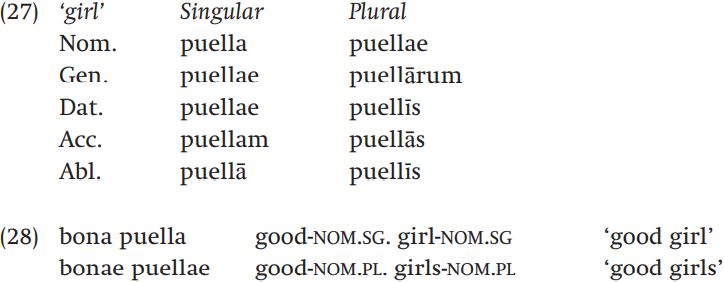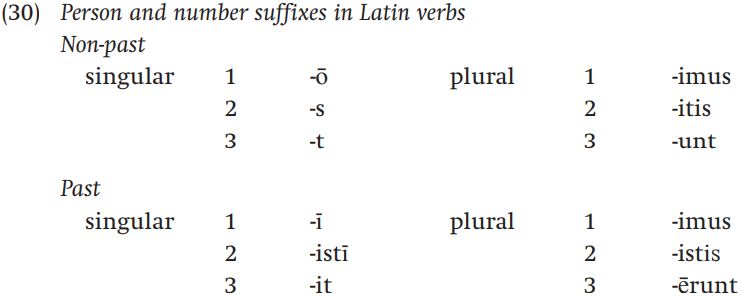


 Grammar
Grammar
 Tenses
Tenses
 Present
Present
 Past
Past
 Future
Future
 Parts Of Speech
Parts Of Speech
 Nouns
Nouns
 Verbs
Verbs
 Adverbs
Adverbs
 Adjectives
Adjectives
 Pronouns
Pronouns
 Pre Position
Pre Position
 Preposition by function
Preposition by function 
 Preposition by construction
Preposition by construction
 Conjunctions
Conjunctions
 Interjections
Interjections
 Grammar Rules
Grammar Rules
 Linguistics
Linguistics
 Semantics
Semantics
 Pragmatics
Pragmatics
 Reading Comprehension
Reading Comprehension|
Read More
Date: 2025-02-11
Date: 2023-08-30
Date: 2024-02-01
|
Like Turkish, and unlike Mandarin and Samoan, Latin is a heavily inflected language. And like Turkish, its inflections are almost entirely suffixal.4 However, its inflection looks rather different from Turkish inflection in that often several meanings are combined into a single inflectional morpheme in Latin. Its toolbag is somewhat larger for derivation than for inflection, with some prefixation and compounding in addition to suffixation. Indeed, you will probably recognize elements of Latin derivational morphology, as many of them have been borrowed into English. We will look at inflection first, then derivation.
Latin nouns are inflected for case, number, and gender, and adjectives are inflected to agree with them. (27) shows the paradigm for the feminine noun puella ‘girl’, and (28) a noun phrase with an agreeing adjective:

Each inflection carries a combination of meanings that includes case, number, and gender. For example, the morpheme -ārum is used in the genitive plural, and in addition, signals that this noun belongs to the first Latin declension, almost all of whose members are feminine in gender.
Verbs have a number of different stems which form the basis of inflectional paradigms that show aspect (imperfect vs. perfect) and voice (active vs. passive), as well as person and number. A portion of the paradigms for the verbs ‘love’ and ‘warn’ are shown in (29

These verb forms are built on one of the stem forms, called the Theme Vowel stem (amā-, monē-) to which a future suffix -bi- or a perfect suffix -v- is attached. Then person and number suffixes are attached. Interestingly, different person and number affixes are used in the past than in other tenses:

In the non-past, the suffixes combine person and number; in some sense, however, the second set of suffixes also signals past tense in addition to person and number, since they are only used in the past tense.
Latin has both derivational suffixes and prefixes. For example, it forms abstract nouns from verb roots by adding the suffix -or:

The suffix -men attaches to either roots or theme vowel stems to form nouns that denote the result of an action:

The prefix amb- attaches to verbs and means ‘around’ and the prefix inattaches to adjectives to form negative adjectives:

Latin does not use compounding as much as English and Germanic languages do, but it does have some compounds:

When two roots are put together into a compound, the linking vowel -i- is used between them.
|
|
|
|
التوتر والسرطان.. علماء يحذرون من "صلة خطيرة"
|
|
|
|
|
|
|
مرآة السيارة: مدى دقة عكسها للصورة الصحيحة
|
|
|
|
|
|
|
نحو شراكة وطنية متكاملة.. الأمين العام للعتبة الحسينية يبحث مع وكيل وزارة الخارجية آفاق التعاون المؤسسي
|
|
|